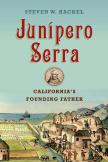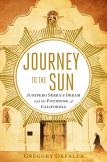God Goes West
Junípero Serra’s instrumental role in establishing the California missions is well known, but the contours of his own life have at times been overshadowed by debates over Spanish colonialism and the mission system. As an emblem of the religious and colonial system he established along the California coast, Serra has been praised by those who celebrate the success of the missions and criticized by those who fault them for their abuses. In these two new biographies, Steven W. Hackel and Gregory Orfalea seek to recover Serra’s own personal story, tracing his life as he journeyed across an ocean and up and down the coast of a continent.
Both authors reveal an appreciation for Serra’s life and legacy, but they employ different narrative styles and differ in their characterization of their shared subject. Hackel, a historian who has written about Indian-Spanish relations in the colonial missions, provides the crisper biography. Though still lively and engaging, his is the more academic study, exhibiting his broad command not just of Serra’s own writings, but of the social, political and religious context of his times. Orfalea, in contrast, employs a more literary approach to his tale. His account can be imaginative or impressionistic at times, but he wants readers to experience the sights, sounds and spectacle of Serra’s travels and ministry.
By all accounts, Serra lived a remarkable life. He was born in 1713 on the island of Mallorca, a Spanish outpost in the Mediterranean where the Catholic Church provided order and institutional stability amid political turbulence and economic hardship. Christened Miguel Joseph, he assumed the name Junípero upon entering the Franciscan order at the age of 17. He would spend the next two decades at the seminary and university, first as a student and then as a professor. The path of Serra’s early life gave little indication of the turn it would take in 1749, when at age 36, having never before left his home island, Serra embarked for the New World. He embraced missionary work as a second career.
Upon his arrival in Mexico, Serra received only a short period of training before being sent to work in the Sierra Gorda, a region north of Mexico City where the missions had stagnated. His renewed outreach to the Indians and his administrative prowess brought him to the attention of his Franciscan superiors and government officials alike. When Spain looked to extend the missions into Alta California as a means of establishing more secure control over the region, Serra’s proven skill made him the clear candidate to lead the campaign.
As daunting as the prospect of establishing the California missions may have been, Serra found the opportunity spiritually invigorating. Unlike other regions, where the missions served those who had already been converted, California offered the chance to reach those who had never before been evangelized. Hackel, in particular, calls attention to Serra’s desire to spread the faith among the “poor” Indians who suffered from lack of a padre. At times prone to romanticize missionary labor, Serra expressed a belief that the Indians would be converted “at the mere sight” of the Franciscans. Even as the missions helped promote Spanish imperial aims, he continued to measure their success in the number of souls saved. For Serra, in Hackel’s telling, “spiritual conquest” remained the true goal.
Serra’s voluminous correspondence from his California days is a blessing for the biographer. The way Hackel and Orfalea approach these sources highlights their interpretive differences. Orfalea mentions that he examined every document of Serra’s he could find, and even discovered in the course of his research a couple of letters that had lain forgotten in remote archives. While he mines these materials well to trace Serra’s comings and goings, he also seems determined to find the traces of Serra’s private life and personal thoughts hidden within Serra’s official reports. After describing the subject of those documents, he is quick to interrogate them for Serra’s emotional state or to describe what Serra might have been feeling at that moment. In describing a letter sent by Serra to the viceroy to report an Indian uprising, for instance, Orfalea speaks of how Serra “seemed to sense violence was inevitable” and how it was almost “as if Serra were asking for forgiveness not only for the Indian, but from him.”
For Hackel, however, it is those very same administrative writings that reveal the true Serra. He argues that one of the things that set Serra apart from his fellow missionaries was his “mastery of the art of composing dry, lengthy, logical, and persuasive memoranda.” As head of the California missions, Serra was responsible for securing resources and protection for them in negotiation with both church and colonial officials. When the political restructuring of the Bourbon reforms threatened the autonomy of the missions, Serra penned numerous appeals and fought vigorously to protect their established privileges. He was particularly concerned about efforts to secularize the missions by removing them from the control of religious orders and turning them over to diocesan priests.
Although both accounts largely avoid the contested legacy of the mission system, they recognize the tensions that arose between the Spanish and their Indian subjects. As Hackel notes, Serra could be blind at times to the resentment caused by the strict moral discipline imposed upon Indian converts, the regimented life within the missions and the use of corporal punishment against transgressors. Yet he also provides context to offer a more sympathetic explanation for Serra’s policies. Since “paternalist rigor” and physical mortification were part of Serra’s own spiritual formation, he demanded the same of others. If Hackel finds any fault with Serra, it is the friar’s reluctance to delegate responsibilities to others even as his declining health made it more difficult for him to oversee the missions. His “desire for absolute control” was something he would relinquish only upon his death in 1784.
Orfalea, though no uncritical apologist, is much more generous toward Serra. He highlights the friar’s various acts of mercy toward the Indians and argues that the real hardship of life within the missions came from the unintended consequences of European disease. His final chapter on the question of sainthood also seeks to make a case for Serra’s sanctity, as exhibited by his “practice of love beyond justice.” More than Hackel, Orfalea is invested in placing Serra’s spiritual legacy in positive light. He meditates on Serra’s virtues and witness, seeking lessons of inspiration to enrich lives today.
Published just months apart, these two biographies draw attention to a pioneering missionary whose life and labors were shaped by the religious character and social order of California and the American West. And while both draw upon the same sources and cover the same ground, they remain markedly different books. Orfalea’s strength lies in his vivid prose and rich descriptions. His narrative style seeks to engage the readers’ imagination and convey the concerns that weighed on Serra’s mind, even if that requires taking “some liberties in reconstructing Serra’s thoughts.” Hackel, though more dispassionate, is better at interrogating Serra’s spiritual impulses and political involvements. While remaining accessible to the general reader, his work sets the new scholarly standard.
This article also appeared in print, under the headline “God Goes West,” in the March 17, 2014, issue.









